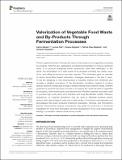Por favor, use este identificador para citar o enlazar a este item:
http://hdl.handle.net/10261/230717COMPARTIR / EXPORTAR:
 SHARE SHARE
 CORE
BASE CORE
BASE
|
|
| Visualizar otros formatos: MARC | Dublin Core | RDF | ORE | MODS | METS | DIDL | DATACITE | |

| Título: | Valorization of Vegetable Food Waste and By-Products Through Fermentation Processes |
Autor: | Sabater, Carlos CSIC ORCID ; Ruíz García, Lorena CSIC ORCID ; Delgado, Susana CSIC ORCID; Ruas-Madiedo, Patricia CSIC ORCID ; Margolles Barros, Abelardo CSIC ORCID | Palabras clave: | Food waste Microbial fermentation By-products valorisation Lactic acid bacteria Bioeconomy |
Fecha de publicación: | 20-oct-2020 | Editor: | Frontiers Media | Citación: | Frontiers in Microbiology 11: 581997 (2020) | Resumen: | There is a general interest in finding new ways of valorizing fruit and vegetable processing by-products. With this aim, applications of industrial fermentation to improve nutritional value, or to produce biologically active compounds, have been developed. In this sense, the fermentation of a wide variety of by-products including rice, barley, soya, citrus, and milling by-products has been reported. This minireview gives an overview of recent fermentation-based valorization strategies developed in the last 2 years. To aid the designing of new bioprocesses of industrial interest, this minireview also provides a detailed comparison of the fermentation conditions needed to produce specific bioactive compounds through a simple artificial neural network model. Different applications reported have been focused on increasing the nutritional value of vegetable by-products, while several lactic acid bacteria and Penicillium species have been used to produce high purity lactic acid. Bacteria and fungi like Bacillus subtilis, Rhizopus oligosporus, or Fusarium flocciferum may be used to efficiently produce protein extracts with high biological value and a wide variety of functional carbohydrates and glycosidases have been produced employing Aspergillus, Yarrowia, and Trichoderma species. Fermentative patterns summarized may guide the production of functional ingredients for novel food formulation and the development of low-cost bioprocesses leading to a transition toward a bioeconomy model. | Versión del editor: | https://doi.org/10.3389/fmicb.2020.581997 | URI: | http://hdl.handle.net/10261/230717 | DOI: | 10.3389/fmicb.2020.581997 | E-ISSN: | 1664-302X |
| Aparece en las colecciones: | (IPLA) Artículos |
Ficheros en este ítem:
| Fichero | Descripción | Tamaño | Formato | |
|---|---|---|---|---|
| fmicb-11-581997.pdf | 2,62 MB | Adobe PDF |  Visualizar/Abrir |
CORE Recommender
PubMed Central
Citations
15
checked on 20-abr-2024
SCOPUSTM
Citations
61
checked on 16-abr-2024
WEB OF SCIENCETM
Citations
44
checked on 29-feb-2024
Page view(s)
131
checked on 23-abr-2024
Download(s)
175
checked on 23-abr-2024

